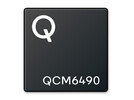Qualcomm Snapdragon 680 4G vs Qualcomm QCM6490
Qualcomm Snapdragon 680 4G
► remove from comparison
The Qualcomm Snapdragon 680 (SD680, SM6225) is a mid-range ARM-based SoC largely found on Android tablets and smartphones. It features 8 Kryo 265 cores (custom design, 64-Bit capable) that are divided in two clusters. A fast cluster of four cores with up to 2.4 GHz (Kryo 265 Gold - Cortex-A73 derivate) and a power saving efficiency cluster with up to 1.8 GHz (Kryo 265 Silver - Cortex A53 derivate). Both clusters can also be used together. Compared to the older Snapdragon 665, the clock speeds are higher.
In addition to the 8 CPU cores, the SoC integrates a mid range Adreno 610 GPU with a LPDDR4 memory controller (dual-channel) and supports Wi-Fi (802.11ac + MIMO, max. 867 Mbps), Bluetooth 5, and LTE (X11 LTE modem with up to 390 Mbps download).
The SoC is produced in 6nm (compared to the older 11nm LPP process of the similar Snapdragon 665).
Qualcomm QCM6490
► remove from comparison
The Qualcomm QCM6490 is an upper mid-range SoC and is based on the Snapdragon 778G, but this variant is an extended-life chipset. The QCM6490 is being used for the first time in the Android smartphone Fairphone 5, but has actually been designed for corporate use and IoT applications.
The Kyro 670 CPU consists of a total of eight cores, which are divided into three clusters. The first cluster consists of just one high-performance core (Kyro Gold Plus, Cortex-A78), which operates at up to 2.71 GHz. The second cluster contains three further Cortex-A78 cores (Kyro Gold), each clocking at up to 2.40 GHz. The remaining four power-saving cores (Kyro Silver, Cortex-A55) are located in the last cluster and operate at up to 1.96 GHz. For the graphics calculations, an Adreno 643 with 812 MHz is integrated.
The QCM6490 SoC has an integrated 5G modem that supports both 5G-Sub6 and 5G-mmWave. In theory, this enables data rates of up to 3.7 Gbit/s downlink and 2.5 Gbit/s upload. Wi-Fi 6E is also on board, which supports the 6 GHz band.
The SoC is manufactured using the 6 nm process.
| Model | Qualcomm Snapdragon 680 4G | Qualcomm QCM6490 | ||||||||||||||||||||||||||||
| Codename | Kryo 265 Gold (Cortex-A73) / Silver (Cortex-A53) | Kryo 670 (Cortex-A78/A55) | ||||||||||||||||||||||||||||
| Series | Qualcomm Snapdragon | Qualcomm Snapdragon | ||||||||||||||||||||||||||||
| Series: Snapdragon Kryo 670 (Cortex-A78/A55) |
|
| ||||||||||||||||||||||||||||
| Clock | 1800 - 2400 MHz | 1960 - 2710 MHz | ||||||||||||||||||||||||||||
| Cores / Threads | 8 / 8 | 8 / 8 | ||||||||||||||||||||||||||||
| Technology | 6 nm | 6 nm | ||||||||||||||||||||||||||||
| Features | Adreno 610 GPU, X11 LTE Modem, Hexagon 686 DSP, Spectra 346 ISP | Dual-Band GNSS, AI Engine (Gen. 6), Hexagon 770, Sensing Hub (Gen. 2), FastConnect 6900, Bluetooth 5.2, Spectra 570L ISP; LPDDR5 (3200 MHz) / LPDDR4x (2133 MHz) | ||||||||||||||||||||||||||||
| iGPU | Qualcomm Adreno 610 | Qualcomm Adreno 643 (812 MHz) | ||||||||||||||||||||||||||||
| Architecture | ARM | ARM | ||||||||||||||||||||||||||||
| Announced | ||||||||||||||||||||||||||||||
| Manufacturer | www.qualcomm.com | www.qualcomm.com |
Benchmarks
Average Benchmarks Qualcomm Snapdragon 680 4G → 100% n=22
Average Benchmarks Qualcomm QCM6490 → 205% n=22
* Smaller numbers mean a higher performance
1 This benchmark is not used for the average calculation












